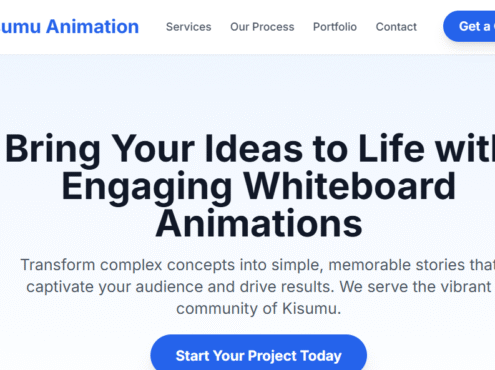Headless CMS Development Kenya
- Delivery Time2 Weeks
- English levelProfessional
- LocationUSA, United Kingdom, United Arab Emirates, New York, Kilimani, Kenya, Dubai, CBD Nairobi, Canada, Australia
Service Description
The cost of Headless CMS Development in Kenya is 600000KES.Get Headless CMS Development in Kenya at a price 4000000KES at Black Shepherd Technologies.
Future-proof your digital presence in Kenya with expert headless CMS development. We build flexible, scalable, and high-performance websites and apps using modern frameworks like React and Next.js. Decouple your content from presentation to power websites, mobile apps, and more from a single, unified content hub. Unlock faster development cycles, better user experiences, and multi-channel content delivery. Partner with our Kenyan-based developers to architect and implement a custom headless CMS solution that meets your business goals and helps you stand out in the competitive digital landscape.
The digital landscape in Kenya is experiencing a rapid transformation, driven by a burgeoning tech-savvy population and a growing number of businesses seeking a robust online presence. In this dynamic environment, the adoption of a modern and flexible content management system (CMS) is no longer a luxury but a necessity. This is where headless CMS development is emerging as a powerful solution, offering unprecedented agility, scalability, and efficiency for businesses of all sizes.
A traditional CMS, like WordPress or Drupal, typically combines the “head” (the frontend, or the user-facing part of the website) and the “body” (the backend, or the content repository and database) into a single, tightly-coupled system. While this model has served the web for decades, it often presents limitations in an era of multi-platform content delivery. Today, content needs to be seamlessly distributed across websites, mobile apps, IoT devices, and even smart displays. A traditional CMS can struggle to adapt to this diverse ecosystem, leading to cumbersome development cycles and fragmented content experiences.
A headless CMS, in contrast, decouples the content repository (the “body”) from the presentation layer (the “head”). The CMS backend becomes a pure content hub, providing a clean and organized way to create, manage, and store content. This content is then exposed through APIs (Application Programming Interfaces) which can be accessed by any “head” or frontend application. This architectural shift offers a multitude of benefits for businesses in Kenya.
One of the most significant advantages is the freedom it gives developers. Instead of being locked into a specific theme or template, developers can use their preferred frontend framework, whether it’s React, Vue.js, Angular, or a static site generator like Next.js or Gatsby. This leads to a more efficient development process, faster loading websites, and a better user experience. For Kenyan businesses aiming to stand out in a competitive market, a blazing-fast, highly-responsive website is a crucial differentiator.
Scalability is another key benefit. As a business grows and expands its digital footprint, a headless CMS can easily accommodate new platforms and channels without a major overhaul of the content management system. A single content repository can power a corporate website, an e-commerce mobile app, and a content-rich PWA (Progressive Web App) simultaneously, ensuring brand consistency and a unified message across all touchpoints. This is particularly relevant for Kenyan companies with ambitions to serve a diverse customer base across various digital channels.
In Kenya, the shift towards headless CMS development is being driven by a number of factors. The rise of e-commerce, the increasing use of mobile apps, and the demand for personalized content experiences are all pushing businesses to adopt more flexible and powerful content management solutions. Local developers are also recognizing the long-term benefits of this architecture, from improved developer workflows to the ability to build highly customized and innovative digital products.
For businesses looking to implement a headless CMS, there are a number of platforms available, both open-source and proprietary. Platforms like Strapi, Contentful, and Sanity are popular choices, each offering a unique set of features and capabilities. Partnering with a skilled and experienced development team in Kenya is crucial for a successful implementation. Such a team can help with everything from selecting the right headless CMS to designing the content models, integrating the APIs, and building the frontend applications.
Ultimately, headless CMS development in Kenya is not just a technological trend; it’s a strategic move that empowers businesses to take control of their digital presence. By separating content from presentation, companies can future-proof their digital assets, innovate faster, and deliver a superior customer experience across every channel. As Kenya’s digital economy continues to grow, headless CMS will play an increasingly vital role in helping businesses build powerful, flexible, and scalable digital solutions.
Headless CMS development is poised to become a cornerstone of Kenya’s digital future. As the market matures and businesses increasingly prioritize a strong, multi-channel online presence, the limitations of traditional CMS are becoming more apparent. The shift towards a headless architecture is not merely a technological upgrade but a strategic move that provides a competitive edge in a dynamic and mobile-first market.
The key benefits of headless CMS—flexibility, scalability, and improved performance—are perfectly aligned with the needs of Kenyan businesses. With high mobile penetration and a growing e-commerce sector, the ability to deliver fast, consistent, and personalized content across websites, mobile apps, and other emerging platforms is critical. By decoupling the front-end from the back-end, businesses can innovate faster, reduce development time, and future-proof their digital assets against a rapidly evolving technological landscape.
Furthermore, the rise of headless CMS in Kenya is creating exciting opportunities for local developers. It empowers them to utilize cutting-edge frameworks and build highly customized solutions, moving beyond the constraints of monolithic systems. As businesses continue to demand more sophisticated and flexible digital experiences, the expertise in headless CMS will be an increasingly valuable skill, driving growth and innovation within Kenya’s tech ecosystem. In essence, adopting a headless CMS is a way for Kenyan businesses to not only keep pace with global trends but also to lead the way in creating truly modern, agile, and effective digital strategies.








